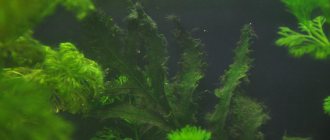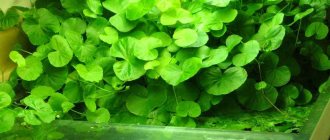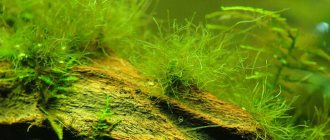Growing and care
The main requirement for growing this moss is crystal water. The suspension in it will lead to a change in color and the appearance of algae. This will slow down growth and lead to rapid rotting of the lower part of the bush.
There is no need to replant the plant. It can be securely attached to any base:
- ground;
- lava;
- driftwood;
- stones.
Be sure to use good filtration and CO2 (aquarists who have managed to grow Ricardia recommend setting 1-2 bubbles per second).
Water parameters for ideal maintenance
The conditions for keeping moss cause a lot of controversy among aquarists. This is due to the unpretentiousness of ricardia. The best results of its cultivation are achieved with soft water enriched with CO2. In such conditions it grows very quickly.
Internal filters should not be used as they create too strong a current. It will tear off pieces from the mother bush and spread it around the aquarium - in this case, the ricardia will turn into a kind of weed.
You need to regularly test your water for nitrates and phosphates. Despite the fact that ricardia takes root well in any water, high concentrations can destroy it. The optimal ratio would be 1 to 15. To find out the content of nitrates and phosphates, perform a drop test.
Lighting requirements
The color intensity of the moss depends on the lighting level:
- if insufficient, it becomes light green;
- with intense – emerald, saturated.
It is best to plant it on decorations that will be placed in the foreground in the brightest places. Then it will quickly grow over them and become a good background and shelter.
Requirements for soil, nutrient substrate
- Absolutely not picky about the soil. In nature it grows even on solidified lava. It pulls in rocks and soil, firmly attaching to it.
- Aquarists often use natural and artificial driftwood as a landing site. This makes it easier to solve the problem of cutting it - the snag needs to be taken out of the water and the excess removed.
Requirement for fertilizers
For better development of moss, mineral fertilizers are used in liquid form.
Care
Caring for aquarium moss is simple and will not cause any problems for the aquarium owner. First of all, caring owners must comply with the required water indicators and monitor the cleanliness of the tank. It is also necessary to monitor the nitrate content in water using tests and other devices to check. In an aquarium with a plant, you should not install devices that create strong water pressure, as this can damage the roots of the mossy flower. Riccardia is planted in a bright, well-lit place, otherwise, with a lack of light, the plant will begin to rot and decompose. It is better if the moss is located in the central part of the reservoir, or in the foreground of the aquarium. If there is not enough lighting, the color of the leaves will tell you - they will begin to lighten.
When planted, the plant is tightly attached to the substrate or to decorative elements, thanks to which picturesque compositions can be created. Most often, riccardia is placed on grottoes, caves or rocks, since the moss beautifully frames the scenery, giving the elements a charming appearance. However, when decorating an aquarium, you should take into account the fact that sometimes small balls independently separate from an adult plant and begin to grow anywhere in the reservoir.
After riccardia adapts to a new place, moss begins to grow and fill the water space. At this time, they are trimmed using a sharp knife, acting carefully and carefully, otherwise the lower stems will begin to rot due to lack of light. Trimming will not harm the green resident, but on the contrary, it will slightly speed up growth.
Riccardia moss is an unusual decorative species of liverwort mosses, which is distinguished by minimal requirements for keeping in an aquarium and a charming appearance. Thanks to these qualities, the plant is often planted by beginning aquarists, creating unique designs of artificial reservoirs. Despite the slow development of the mossy flower, with proper care and maintenance the plant will grow lush and will delight the owner with its blooming appearance.
Reproduction
When propagating, it is better to divide a piece of moss into thin branches. You need to achieve thin and flat pieces that need to be tied to the base or pinned with a button. If the moss ball is too thick, it will not have enough light to develop, and the lower part, which should be attached to the base, will begin to rot.
There is a way to glue moss for propagation:
- You will need to take driftwood, any glue related to cyanoacrylates, you can try medical compounds.
- Wipe part of the driftwood dry with a cloth.
- Apply a drop of glue and place a twig on it for propagation. To make the base covered with moss faster, attach several pieces this way.
- Let the glue dry a little, then lower the decoration into water.
In the first week, it is better to place the snag with a piece of moss in the shade - during this period it adapts to the new habitat (hardness and acidity of water, temperature). The development of ricardia should not be checked too often. The first time you need to remove the button no earlier than after 2 weeks. If threads were used, then you should not touch the moss.
Keeping Ricardia chamedrifolia in an aquarium
Chamedrifolia is not picky in its conditions of detention; it can even adapt to running water. In general, water parameters do not have any special requirements. The main thing is that the water should be as clear as possible. If the moss is in a polluted environment, all the debris will collect on it and the plant will soon become covered with algae. To avoid this, install a cleaning filter. Internal filters are not suitable for this purpose; they create too strong a current. It is better to use a bottom filter or drainage system.
It is enough to provide a bright location and slightly increase the amount of CO2 and moss content will not be a difficult process. Remember, moss grows slowly at first. The adaptation period can take from several days to several weeks. Just like underwater riccias, they need constant pruning to avoid rotting of the lower part and complete death. It is imperative to trim young shoots, otherwise this will lead to rotting of the lower layers, resulting in the formation of a substrate for young plants. As a result, entire colonies may die. When cutting a layer of moss, it is better to use a blade.
The main disadvantage is that when small clumps often separate from the mother plant, they spread uncontrollably throughout their aquarium. He also doesn't like high temperatures.
Moss feels great at temperatures from 18°C to 25°C, water hardness 5-9°, water acidity 5.5-7.5. It is recommended to monitor the level of phosphates and nitrates, the ratio should be approximately 1 to 15, this is best done using drop tests. Fertilizers should be applied very carefully only when necessary, and in addition to mosses, it is a good idea to keep fast-growing plants that can process excess organic matter.
It is best to keep small fish in an aquarium with mosses that do not spoil the plants. To keep moss clean, shrimp, the most popular, and the unpretentious cherry shrimp, the most effective amano, help well.
To keep the plants in proper shape, it is necessary to regularly remove any debris that has settled on them using a siphon. If it is difficult to get through thickets of moss with a standard siphon, then you can use a thin tube with a flattened end as a nozzle. This will clear the soil in the most inaccessible places.
Another form of riccardia
There is a rarer form of ricardia - Riccardia Graeffei. It differs from Chamedryfolia in several ways:
| Parameter | Difference |
| Appearance | Larger than its relative, the leaves are more fleshy, the branches are more massive. |
| Lighting | More demanding of lighting, may develop poorly even from lamps of the wrong spectrum. Good results can be achieved with 1W per 1 liter. water (Sylvania Grolux). |
| Water quality | The optimal parameters are: Ph – 6; Gh – 7; KH – 0. Additional carbon supply is required, but fertilizers can be abandoned. Deviations from these parameters are acceptable, but not significant. |
It is more demanding in terms of living conditions; without the attention of the owner, it begins to turn black and die. The reason for this may also be the algaecide Sidex - when used, poor growth and death of moss is often observed.
Description
Riccardia Hamedrifolia is a rare species of liver moss native to Taiwan. Under natural wild conditions, the plant grows in the waters of South America, and the mossy flower was discovered relatively recently - in 2005. To date, about 300 varieties of chamedrifolia have been described, but only five varieties are publicly available.
Riccardia moss is characterized by slow growth and takes a long time to get used to its new place of residence, so in an aquarium when a southern guest is planted, riccardia may not develop for about a month until it finally gets used to the tank. However, even a novice aquarist can maintain this mossy flower, since the plant is unpretentious.
The appearance of the moss is memorable and unusual - like all representatives of the liver, riccardia spreads along the bottom of the tank, growing up to 4 cm in height. The stems of the plant are thick, fleshy, and the leaves have a dissected shape and a rich green color. Thanks to its pretty appearance, riccardia moss decorates many artificial reservoirs, creating an imitation of real underwater depths.
Life hacks and content tips
The main problem of ricardia is slow growth.
You can speed it up with good lighting, and the plant will be more lush in soft water. As it develops, the moss will need to be trimmed regularly. By trimming, experienced aquarists mean a process in which entire layers of ricardia are removed from the bush using a blade.
If you don't do this, the plant will begin to rot from below. You can't get away with this with simple scissors; using a blade will work faster.
To clean the thickets from contaminants, you can use a standard siphon or a thin tube.
It is important to keep the moss neat, otherwise it will not develop well. If pieces are detached from the mother plant, they need to be caught and regrown, or thrown out. These branches can cause the ricardia to end up not where you would like it to be.
Appearance of Riccardia chamedrifolia, "Mini Pellia"
The small liverwort is very decorative. Like all liver mosses, they creep along the substrate, and are only 2-4 cm high. For them, water at 18-24 ° C will be a favorable growth environment, but even at higher temperatures the mosses will not die, but overheating is not desirable. The thallus grows up to 6 cm in length and up to 5 mm in width. It has a dark green color, fleshy stems, palmate or pinnate branching.
Branchlets of archegonia are very dissected or have hairy edges of a characteristic pale brown green color. Fleshy cap 3-10mm long.
Riccardia, depending on the conditions of detention, can change their appearance quite significantly. For example, if there is not enough light, they can change their color to a lighter one.
Riccardia
Riccardia chamedryfolia
Habitat: Riccardia chamedrifolia grows naturally in water bodies of South America. The plant was discovered in 2005 in Taiwan. Currently, there are about 300 species of this plant, although no more than 5 species can be found in trade.
Description: Riccardia chamedryfolia has a decorative appearance. Like all liver mosses, it spreads along the surface of the soil, up to 4 cm in height. The leaves of the plant are dark green in color. The stems are quite fleshy. The branches of the plant have a dissected structure with a hairy edge.
Conditions of maintenance: In general, the plant does not have high requirements for its maintenance and can be recommended for beginning aquarists.
However, riccardia is capable of significantly changing its appearance depending on the conditions surrounding it. So, with insufficient lighting, the leaves of the plant significantly change their color, becoming lighter.
The water in the aquarium should be crystal clear; if the water contains fine suspension, then settling on the leaves of the plant it will provoke the growth of algae on them. Effective filtration is required. The plant does not tolerate excessive amounts of organic matter in water.
To successfully grow moss, you need to choose a suitable, brightest place for it in the aquarium. Systematic feeding of CO2 also has a good stimulating effect on growth.
When planted in a new place, moss takes a relatively long time to adapt to new conditions. This period may take more than a month, after which the plant begins to slowly grow and will require periodic trimming. This is done to prevent the lower part of the bush from rotting from lack of light.
Water parameters:
Temperature 18-25°C, water temperature should not be higher than indicated, because in this case, the plant begins to hurt and may die as a result.
Hardness dH 5-10°,
Acidity pH 5.5-7.5,
Lighting can be either moderate or strong. The duration of daylight is about 10 hours a day.
Location in the aquarium: It is advisable to plant Riccardia chamedrifolia in the foreground, but if desired, you can plant it in any bright place in the aquarium. Very beautifully, this moss can be used to decorate various stones, grottoes and driftwood, giving them a very picturesque look. A distinctive characteristic of this moss is that it grows very strongly onto various decorations and subsequently they can be moved to different parts of the aquarium without any problems.
Compatibility with aquarium inhabitants: it is impossible to keep herbivorous fish in an aquarium together with this moss. It is best to keep various small fish, as well as shrimp, for example, amano and cherry shrimp, which will harmonize perfectly against the background of riccardia, and also take care of the cleanliness of its leaves, eating various particles that have settled on them.











